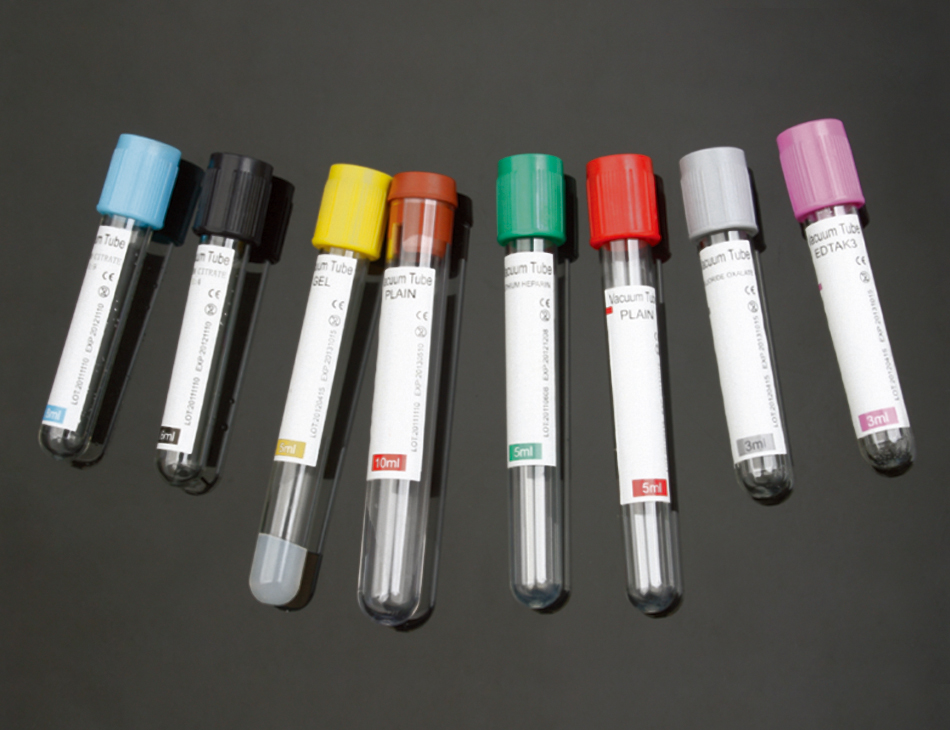
Vacuum Blood Collection
Vacuum blood collection tubes are medical devices used to collect a predetermined volume of blood.
Glass and plastic tubes available
50mm, 75mm,100mm, 1ml, 2ml, 3ml, 4ml, 5ml, 6ml, 7ml available
| Ref. No.: | Description: |
|---|---|
| NME110001 | Heparin Tubes |
| NME110002 | No-anti Coagulation Tubes |
| NME110003 | PT Tubes |
| NME110004 | ESR Tubes |
| NME110005 | Oxalate Tubes |
| NME110006 | Pro-coagulation Tubes |
| NME110007 | EDTA. K2 Tubes |
| NME110008 | Gel and Clot Activator Tubes |
Vacuum blood collection tubes are used to collect and store blood samples. They are made of plastic and have a vacuum-sealed stopper. The tubes come in different sizes and colors, each of which has a different purpose. The most common type of vacuum blood collection tube is the 10 mL tube. This tube is used for routine blood tests, such as a complete blood count (CBC) or a basic metabolic panel (BMP). The 10 mL tube has a plain white stopper and is often called a "plain" or "clotting" tube. There are also smaller 3 mL and 5 mL tubes. These tubes are used for specific tests that require only a small amount of blood, such as a glucose test or a cholesterol test. The 3 mL and 5 mL tubes have colored stoppers (red, green, or blue) that indicate what type of test the sample is for. Vacuum blood collection tubes can be stored at room temperature or in the refrigerator. They should be used within 48 hours of collection.
A vacuum blood collection tube is a type of container that is used to collect and store blood samples for laboratory testing. The tube has a small opening at one end that is connected to a vacuum source, and a larger opening at the other end for collecting blood. The vacuum in the tube helps to draw blood into the container without the need for syringes or needles. This makes it a safer and more comfortable option for both patients and healthcare providers. Blood collection tubes are also less likely to leak than other types of containers, making them ideal for collecting and storing blood samples.
When you go to get your blood drawn, the phlebotomist will usually have a selection of different vacuum blood collection tubes. Each tube has a different purpose, and the correct tube must be used for the correct test. Here is a quick explanation of the different types of vacuum blood collection tubes and how to use them:
Red Top Tube: This tube is used for tests that require serum. To collect serum, the phlebotomist will first draw blood into an evacuated tube. The tube contains a chemical separator that will allow the plasma to be separated from the cells. The plasma is then transferred into a red top tube.
Green Top Tube: This tube is used for tests that require heparinized plasma or whole blood. Heparin is an anticoagulant that prevents the blood from clotting. To collect heparinized plasma, the phlebotomist will first draw blood into an evacuated green top tube. The tube contains a small amount of heparin, which will prevent the blood from clotting. The plasma is then separated from the cells and transferred into another tube.
Blue Top Tube: This tube is used for tests that require EDTA plasma or whole blood. EDTA is an anticoagulant that prevents the blood from clotting. To collect EDTA plasma, the phlebotomist will first draw blood into an evacuated blue top tube. The tube contains a small amount of ED TA, which will prevent the blood from clotting. The plasma is then separated from the cells and transferred into another tube.
Gray Top Tube: This tube is used for tests that require lithium heparin plasma or whole blood. Lithium heparin is an anticoagulant that prevents the blood from clotting. To collect lithium heparin plasma, the phlebotomist will first draw blood into an evacuated gray top tube. The tube contains a small amount of lithium heparin, which will prevent the blood from clotting. The plasma is then separated from the cells and transferred into another tube.
Pink Top Tube: This tube is used for tests that require sodium citrate plasma or whole blood. Sodium citrate is an anticoagulant that prevents the blood from clotting. To collect sodium citrate plasma, the phlebotomist will first draw blood into an evacuated pink top tube. The tube contains a small amount of sodium citrate, which will prevent the blood from clotting. The plasma is then separated from the cells and transferred into another tube.
There are a number of other potential uses for vacuum blood collection tubes beyond those already mentioned. For example, they can be used to collect DNA samples for genetic testing, or to collect cells for analysis in a laboratory. Additionally, vacuum blood collection tubes can be used to collect blood samples from animals for research purposes. Vacuum blood collection tubes are also sometimes used in the field of forensic science. For example, they may be used to collect blood samples from crime scenes in order to identify the DNA of the perpetrator. Additionally, vacuum blood collection tubes can be used to collect blood samples from living people in order to compare their DNA with that of a crime scene sample.
Vacuum blood collection tubes are made of plastic and have a rubber stopper at the top. They come in various sizes, but the most common size is the 10 mL tube. These tubes contain an anticoagulant, which helps to prevent the blood from clotting. There are different types of anticoagulants that can be used, but the most common one is heparin.